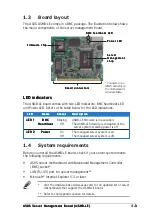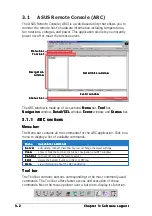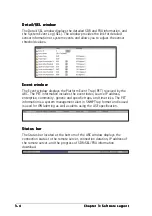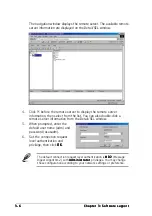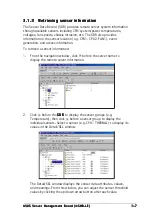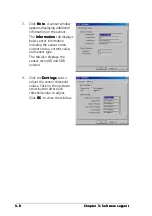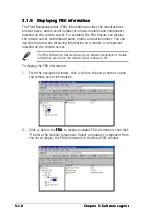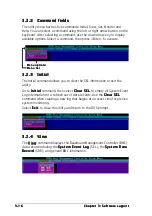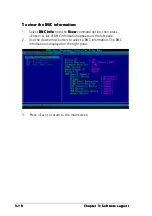
A S U S S e r v e r M a n a g e m e n t B o a r d ( A S M B - L E )
A S U S S e r v e r M a n a g e m e n t B o a r d ( A S M B - L E )
A S U S S e r v e r M a n a g e m e n t B o a r d ( A S M B - L E )
A S U S S e r v e r M a n a g e m e n t B o a r d ( A S M B - L E )
A S U S S e r v e r M a n a g e m e n t B o a r d ( A S M B - L E )
3 - 3
3 - 3
3 - 3
3 - 3
3 - 3
Navigation window
Navigation window
Navigation window
Navigation window
Navigation window
The Navigation window displays the directory of
connected and disconnected remote server(s).
For multiple monitoring, this window allows you to
navigate through the remote servers. Click the
All Servers
All Servers
All Servers
All Servers
All Servers root directory to display all
connected and disconnected servers, then click
on the server you want to monitor or control.
Click before the server connection to display available remote server
information including the Sensor Data Record (SDR), Field Replaceable Unit
(FRU), and System Event Log (SEL).
Some remote server information (such as the SDR) contains several sensor
groups such as T e m p e r a t u r e
T e m p e r a t u r e
T e m p e r a t u r e
T e m p e r a t u r e
T e m p e r a t u r e, V o l t a g e
V o l t a g e
V o l t a g e
V o l t a g e
V o l t a g e, F a n
F a n
F a n
F a n
F a n, and C h a s s i s I n t r u s i o n
C h a s s i s I n t r u s i o n
C h a s s i s I n t r u s i o n
C h a s s i s I n t r u s i o n
C h a s s i s I n t r u s i o n.
Click before the remote server information to display the sensor groups.
Click before a sensor group to display individual sensors. For example,
clicking before the sensor group T e m p e r a t u r e
T e m p e r a t u r e
T e m p e r a t u r e
T e m p e r a t u r e
T e m p e r a t u r e displays the CPU1 and
system temperatures.
You can also change the server directory
display by clicking the buttons on top of the
window. For example, clicking the I P
I P
I P
I P
I P button
displays the remote server IP address instead
of the remote server name (N
N
N
N
N). Selecting I D
I D
I D
I D
I D
displays the remote server ID instead of the
server name or IP address.
S e n s o r g r o u p s
S e n s o r g r o u p s
S e n s o r g r o u p s
S e n s o r g r o u p s
S e n s o r g r o u p s
S e n s o r s
S e n s o r s
S e n s o r s
S e n s o r s
S e n s o r s
Summary of Contents for ASMB-LE
Page 1: ...ASMB LE Server Management Board ...
Page 10: ...x x x x x ...

